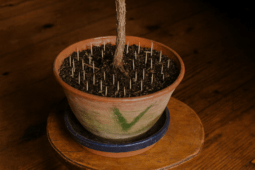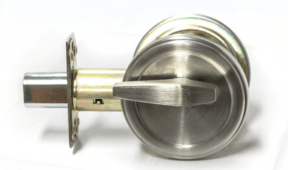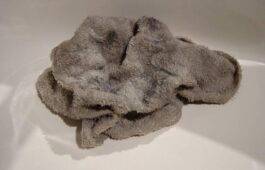How To: Make DIY Gradient Typographic Wall Art

Wood.
It’s my favorite material to work with, hands down. I love the way it makes my car smell when I bring it home from the lumberyard. I love that it goes from a roughly-textured square to any shape I can imagine, and unbelievably smooth when you sand it.
But the best part? Seeing the full character of the grain come through during that last step – finishing the wood with stain or oil. Not until you rub that rag over the surface does the wood truly come alive. So, I wanted to see if I could come up with a way to use a finishing technique – staining the wood – as part of the creative process. I’m always surprised by what a difference multiple coats of stain makes. Unlike opaque paint, which just fills in gaps and brush strokes with a second coat, the transparent stain becomes darker and richer with each application. So, I came up with a way to take advantage of what happens with multiple coats – a gradient stain technique, in which each layer becomes darker with each coat, creating a fading, ombré wood stain effect across the piece.
Materials and Tools:
- Wood or plywood sheet – I used 2×4′ 3/4″ birch plywood “handy panel”
- Jigsaw
- Sandpaper
- ScotchBlue painters tape
- Long straight edge or yardstick
- Light color wood stain (I used water-based)
- Foam brush or paint brush
- Paste wax or acrylic clear coat
1. Draw your shape on the plywood. I’m not much of a free-hander, so I used an overhead projector that I keep around for just this purpose to get the image onto the plywood.
To prevent my transparency from moving mid-trace, I used a bit of ScotchBlue painter’s tape to hold it down.

2. Cut out your shape. I used one of my favorite tools – the jigsaw – to cut out the shape. If you don’t have one, you could also use an inexpensive coping saw, which you can get at the hardware store for less than $20.
Be sure to cut just outside of your line with the jigsaw, so that you can use sandpaper to sand it to the final shape. On curves and sharp turns, sometimes it’s best to make several passes until you can accurately turn the saw to make the cut without going into the final shape.

3. Sand it! Starting with a coarse-grain sandpaper (80-100), sand your design to shape along the edges (don’t apply the coarse grit to the face, as you’ll just have to smooth it out later). Use a small block on the edges, and a dowel rod or wooden spoon on the round parts to maintain the curves.
Then, sand the entire thing with a medium grit (150) to a fine grit, such as 220. If you’re obsessive like me, you can sand the edges to 320, so that the stain soaks up easily, but this step is totally optional.
4. Start making stripes. Since my design turned out to be around 17.5″ tall, I decided I’d go for ten layers around 1.75″ each. More than anything, I wanted to experiment with what was really possible with the technique, so I wanted to go all out with many layers. This approach would work equally well with 5-7 layers, or even less on a smaller piece, so just figure out what works best for you.
Use ScotchBlue painter’s tape to mark the top of the line, and press down to secure across the width. I found using a long straight edge made this process super easy and quick. You don’t want to use any pencil marks here, as you won’t be able to sand them away, and they’ll appear on the final project under the stain.
Before staining, be sure to also cover the edges of the wood. If you shape has slants and angles like mine, the tape is not going to bend at 90°, so just snip it off at the edge, and reapply to make everything square.
5. Staining. Begin by staining the first layer with an even coat. Following the manufacturers directions, allow the stain to penetrate, and then wipe off any excess. I found a good rhythm of staining, waiting seven minutes, then wiping off the whole thing with a rag, and taping and staining the next layer immediately. That way, the whole thing was done in about an hour, and I had time to accomplish other little tasks in between.
The idea here is to build up layers of color with each level. So, with each new line, you want to restain the entire piece below the tape line. So the bottom level has ten coats, the next nine, then eight, seven, six, etc.

As you continue to stain, you start to see how the layers interact. It’s cool to see the gradient starts to form, and how each level becomes the previous’ color as you add stain. On layers seven and eight, I added a little bit of water to my stain cup to lighten the color. If you’re using an oil-based stain, you’ll need to add an oil-based product like mineral spirits or paint thinner. I added a little bit more water on layers nine and ten, so the top level is just barely tinted. I’ll admit, I was pleasantly surprised by how well it turned out, with the colors fading very, very evenly.
6. Seal it. Allow the layers of stain to cure fully according the package directions, likely twenty-four hours. Then, add a final clear coat to the whole piece. I used a rub-on paste wax, which you can find at any hardware store, since I wanted a softer, more matte finish, but you could also use an acrylic or polyurethane clear coat.
Then, just add a small picture hanger in the back, and hang it up!
Please post any questions or ideas in the comments below, and extra big thanks to ScotchBlue for making this project possible!
Visit ScotchBlue Ribbons on Facebook to learn how to win one of hundreds of daily samples!















